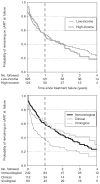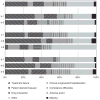Deferred modification of antiretroviral regimen following documented treatment failure in Asia: results from the TREAT Asia HIV Observational Database (TAHOD)
- PMID: 19601993
- PMCID: PMC2863153
- DOI: 10.1111/j.1468-1293.2009.00738.x
Deferred modification of antiretroviral regimen following documented treatment failure in Asia: results from the TREAT Asia HIV Observational Database (TAHOD)
Abstract
Objective: The aim of the study was to examine the rates and predictors of treatment modification following combination antiretroviral therapy (cART) failure in Asian patients with HIV enrolled in the TREAT Asia HIV Observational Database (TAHOD).
Methods: Treatment failure (immunological, virological and clinical) was defined by World Health Organization criteria. Countries were categorized as high or low income by World Bank criteria.
Results: Among 2446 patients who initiated cART, 447 were documented to have developed treatment failure over 5697 person-years (7.8 per 100 person-years). A total of 253 patients changed at least one drug after failure (51.6 per 100 person-years). There was no difference between patients from high- and low-income countries [adjusted hazard ratio (HR) 1.02; P=0.891]. Advanced disease stage [Centers for Disease Control and Prevention (CDC) category C vs. A; adjusted HR 1.38, P=0.040], a lower CD4 count (>or=51 cells/microL vs. <or=50 cells/microL; adjusted HR 0.61, P=0.022) and a higher HIV viral load (>or=400 HIV-1 RNA copies/mL vs. <400 copies/mL; adjusted HR 2.69, P<0.001) were associated with a higher rate of treatment modification after failure. Compared with patients from low-income countries, patients from high-income countries were more likely to change two or more drugs (67%vs. 49%; P=0.009) and to change to a protease-inhibitor-containing regimen (48%vs. 16%; P<0.001).
Conclusions: In a cohort of Asian patients with HIV infection, nearly half remained on the failing regimen in the first year following documented treatment failure. This deferred modification is likely to have negative implications for accumulation of drug resistance and response to second-line treatment. There is a need to scale up the availability of second-line regimens and virological monitoring in this region.
Figures


Similar articles
-
The significance of HIV 'blips' in resource-limited settings: is it the same? analysis of the treat Asia HIV Observational Database (TAHOD) and the Australian HIV Observational Database (AHOD).PLoS One. 2014 Feb 7;9(2):e86122. doi: 10.1371/journal.pone.0086122. eCollection 2014. PLoS One. 2014. PMID: 24516527 Free PMC article.
-
Measures of site resourcing predict virologic suppression, immunologic response and HIV disease progression following highly active antiretroviral therapy (HAART) in the TREAT Asia HIV Observational Database (TAHOD).HIV Med. 2010 Sep;11(8):519-29. doi: 10.1111/j.1468-1293.2010.00822.x. Epub 2010 Mar 21. HIV Med. 2010. PMID: 20345881 Free PMC article.
-
Treatment failure and mortality factors in patients receiving second-line HIV therapy in resource-limited countries.JAMA. 2010 Jul 21;304(3):303-12. doi: 10.1001/jama.2010.980. JAMA. 2010. PMID: 20639564
-
[National consensus document by GESIDA/National Aids Plan on antiretroviral treatment in adults infected by the human immunodeficiency virus (January 2011 update)].Enferm Infecc Microbiol Clin. 2011 Mar;29(3):209.e1-103. doi: 10.1016/j.eimc.2010.12.004. Enferm Infecc Microbiol Clin. 2011. PMID: 21388714 Spanish.
-
Study of the impact of HIV genotypic drug resistance testing on therapy efficacy.Verh K Acad Geneeskd Belg. 2001;63(5):447-73. Verh K Acad Geneeskd Belg. 2001. PMID: 11813503 Review.
Cited by
-
Drug-Related Problems in HIV Treatment Failure.Cureus. 2024 Sep 21;16(9):e69838. doi: 10.7759/cureus.69838. eCollection 2024 Sep. Cureus. 2024. PMID: 39435225 Free PMC article.
-
Time to Switch to Second-Line Anti-Retroviral Treatment and Its Predictors Among HIV Infected Adults with Virological Failure in Northwest Ethiopia: A Retrospective Follow-Up Study.HIV AIDS (Auckl). 2022 Mar 5;14:87-100. doi: 10.2147/HIV.S348076. eCollection 2022. HIV AIDS (Auckl). 2022. PMID: 35281768 Free PMC article.
-
Treatment modification after second-line failure among people living with HIV in the Asia-Pacific.Antivir Ther. 2020;25(7):377-387. doi: 10.3851/IMP3388. Antivir Ther. 2020. PMID: 33843656 Free PMC article.
-
Efficacy of second-line antiretroviral therapy among people living with HIV/AIDS in Asia: results from the TREAT Asia HIV observational database.J Acquir Immune Defic Syndr. 2015 Feb 1;68(2):186-95. doi: 10.1097/QAI.0000000000000411. J Acquir Immune Defic Syndr. 2015. PMID: 25590271 Free PMC article.
-
Second-line antiretroviral therapy regimen change among adults living with HIV in Amhara region: a multi-centered retrospective follow-up study.BMC Res Notes. 2019 Jul 15;12(1):407. doi: 10.1186/s13104-019-4429-3. BMC Res Notes. 2019. PMID: 31307513 Free PMC article.
References
-
- WHO. Towards Universal Access, Scaling up Priority HIV/AIDS Interventions in the Health Sector, Progress Report 2008. Geneva: World Health Organization; 2008.
-
- Hammer SM, Saag MS, Schechter M, et al. Treatment for adult HIV infection: 2006 recommendations of the International AIDS Society-USA Panel. JAMA. 2006;296:827–843. - PubMed
-
- WHO. Antiretroviral Therapy for HIV Infection in Adults and Adolescents. Recommendations for a Public Health Approach. 2006 Revision. Geneva: World Health Organization; 2006.
-
- Spacek LA, Shihab HM, Kamya MR, et al. Response to antiretroviral therapy in HIV-infected patients attending a public, urban clinic in Kampala, Uganda. Clin Infect Dis. 2006;42 :252–259. - PubMed
Publication types
MeSH terms
Substances
Grants and funding
LinkOut - more resources
Full Text Sources
Medical
Research Materials

